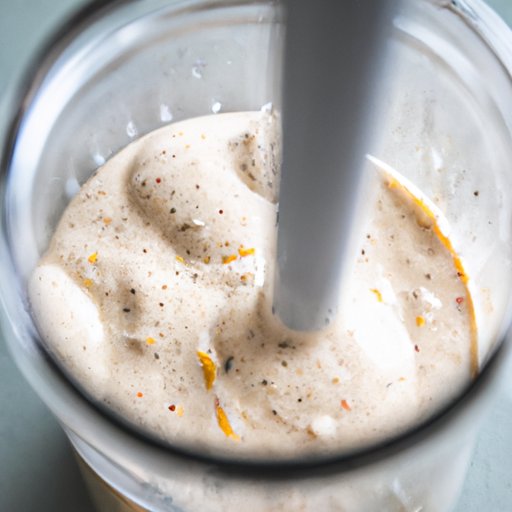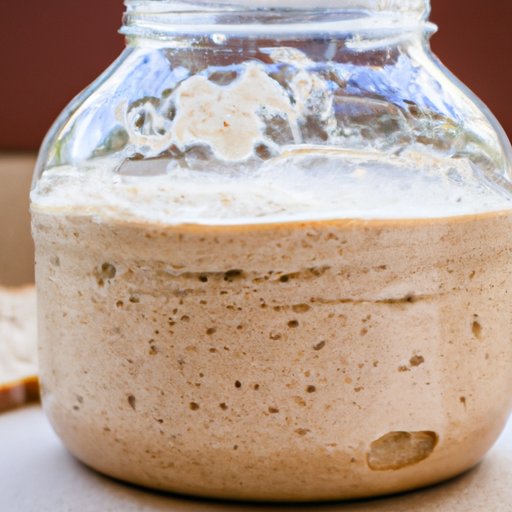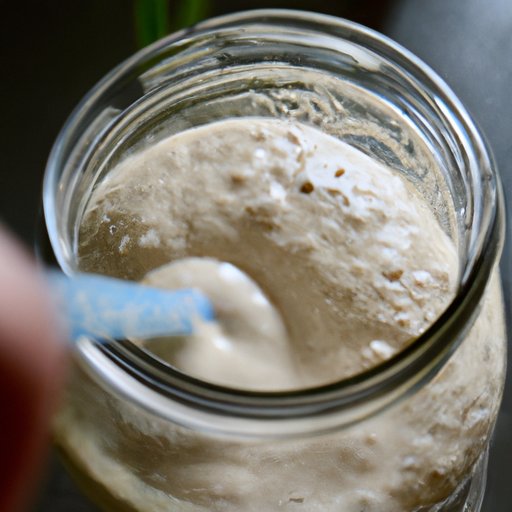Introduction
Sourdough bread is a popular and flavorful way to enjoy freshly baked bread, but it requires a few special ingredients to make it just right. One of those ingredients is a sourdough starter, which is a mixture of flour, water, and naturally occurring yeast and bacteria. This starter is what gives sourdough bread its signature flavor and texture.
This article will explore how to feed sourdough starter, including preparing it from scratch, feeding it with flour and water, storing it for later use, troubleshooting common problems, and offering tips for successful feeding. Finally, readers can try out some delicious recipes that use sourdough starter.

Preparing Sourdough Starter from Scratch
If you’re starting from scratch, you’ll need a few simple ingredients to get your sourdough starter going. According to the book The New Sourdough: A Step-by-Step Guide to Sourdough Baking at Home by Mark Diacono, you’ll need “plain white flour, mature live yoghurt (optional) and water.”
To begin, mix together equal parts of flour and water in a bowl or jar. For example, if you’re using one cup of flour, you’ll also need one cup of water. If you’re adding mature live yoghurt, you’ll start with a smaller amount, such as two tablespoons, and then add more as needed.
Cover your bowl or jar with a lid or cloth and let it sit at room temperature for 24 hours. As the mixture sits, the natural yeasts in the air will combine with the flour and water to create your sourdough starter. After 24 hours, check your starter to see if it has risen and looks bubbly. If it does, it’s ready to use. If not, cover it again and let it sit for another 24 hours.
Feeding Sourdough Starter with Flour and Water
Once your starter is ready to use, you’ll need to feed it with flour and water regularly to keep it alive and active. According to the book The Bread Bible by Rose Levy Beranbaum, “A starter needs to be fed at least twice a day when it is young and vigorous to maintain its activity.”
When feeding your starter, you’ll want to use equal parts of flour and water. For example, if you’re using one cup of flour, you’ll also need one cup of water. You can use any type of flour you like, but most bakers prefer unbleached all-purpose flour for their starters.
To feed your starter, add equal parts of flour and water to the starter and mix until combined. Cover your bowl or jar with a lid or cloth and let it sit at room temperature for about 8 hours. Then, discard half of the starter and repeat the process with fresh flour and water.
Storing Sourdough Starter for Future Use
If you don’t plan on using your sourdough starter right away, you can store it in the refrigerator or freezer for future use. To store in the refrigerator, transfer your starter to a clean, airtight container and store in the refrigerator for up to two weeks. To store in the freezer, transfer your starter to a freezer-safe container and freeze for up to three months.
When you’re ready to use your starter again, thaw it in the refrigerator overnight and feed it with fresh flour and water before using.

Troubleshooting Common Problems with Feeding Sourdough Starter
If you’re having trouble getting your starter to rise or stay active, there could be a few different causes. According to The New Sourdough, some of the most common problems include “too much or too little flour and water, insufficient time for fermentation, or too cold or hot temperatures.”
To troubleshoot these problems, start by adjusting the amounts of flour and water you’re using. Make sure you’re using equal parts of each and that you’re giving your starter enough time to ferment before using it. Additionally, pay attention to the temperature of your kitchen and adjust accordingly.

Tips for Feeding Sourdough Starter
To get the best results when feeding your starter, there are a few tips you should follow. First, make sure you’re using the right ratio of flour and water. According to The Bread Bible, “A good ratio is 2 parts flour to 1 part water by weight.”
Next, make sure you’re paying attention to the temperature of your kitchen. Yeast likes warm temperatures, so if your kitchen is too cold, your starter may not rise. Aim for a temperature between 70-80°F for the best results.
Finally, timing is important when it comes to feeding your starter. Try to feed it at the same time every day to keep it on a regular schedule. This will help keep it active and make it easier to use.
Recipes Using Sourdough Starter
Now that you know how to feed sourdough starter, why not put it to use? Here are a few delicious recipes that use sourdough starter:
Conclusion
Feeding sourdough starter is an easy and rewarding process that anyone can do. With the right ingredients, instructions, and tips, you can create a delicious and flavorful sourdough bread. So, grab your flour and water, and get started!
In this article, we explored how to feed sourdough starter, including preparing it from scratch, feeding it with flour and water, storing it for later use, troubleshooting common problems, and offering tips for successful feeding. We also shared some delicious recipes that use sourdough starter.
By following these steps, you can create a delicious and flavorful sourdough bread that your whole family will love.
(Note: Is this article not meeting your expectations? Do you have knowledge or insights to share? Unlock new opportunities and expand your reach by joining our authors team. Click Registration to join us and share your expertise with our readers.)
